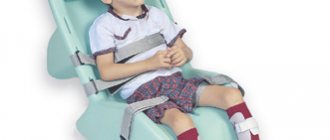Schizophrenia in adolescents often manifests itself unexpectedly and quite violently, usually with vivid manifestations. However, in some cases it can begin unnoticed by parents, who often consider the onset of the disease to be a manifestation of a pubertal state. And this is quite understandable because pubertal manifestations and manifestations of schizophrenia are very similar.
It should be noted that therapy for schizophrenia in adolescents is more effective the earlier it is started. At this age, it is very dangerous to delay treatment. This is due to the fact that schizophrenia in adolescents is dangerous because the degradation phase occurs faster. This is due to the additional load of unstable hormonal levels.
Schizophrenia can affect a person of any age, including adolescence. About 30% of patients first develop symptoms of this disease between the ages of 10 and 20 years. Schizophrenia in adolescents is 4 times higher than in adults.
Schizophrenia in adolescents - signs
Adolescent schizophrenia is a process associated with the formation in a teenager of a pathological mental and emotional state in the perception of the surrounding reality. At the beginning of the development of schizophrenia in adolescents, signs of psychopathy come to the fore: disobedience, aggressiveness, refusal to attend school, sexual deviations.
The main sign of schizophrenia in adolescence is the intensification of negative emotions almost instantly, the occurrence of disturbances in thinking, severe autism, and a decrease in general activity. Adolescent and adult schizophrenia differ significantly. In this age category, the onset of schizophrenia rarely manifests itself in the form of hallucinations and delusions.
Schizophrenia in adolescents
- paranoid - manifests itself as delusion in the form of incorrect interpretation of events and one’s own experiences, dysmorphomania is common (discovery of a defect in appearance that actually does not exist);
- simple - can begin with a difficult character and outbursts of aggression, followed by a sharp decrease in activity and poverty of interests;
- residual - against the background of the absence of acute manifestations of schizophrenia, lethargy, low social activity, and indifference to one’s appearance remain;
- hebephrenic - manifested by elements of child behavior: grimacing, mannerisms, extreme manifestations of autism;
- catatonic – currently quite rare; there is stupor or unproductive motor activity, negativism, freezing in unusual positions.
According to the type of course, schizophrenia is divided into continuous and paroxysmal.
SIGNS OF THE DISEASE
Regarding schizophrenia, a simple rule applies: the earlier the disorder is detected, the better the prognosis. Early childhood schizophrenia manifests itself in infancy. However, few parents think about the presence of the disease, rather justifying the symptoms of a mental disorder with crisis periods of development or shortcomings in upbringing.
Since children tend to fantasize and have unstable mental reactions, the disease is difficult to diagnose before the age of 7. Psychiatrists lack a clear picture to make a diagnosis. More often, an official conclusion is made at puberty, during the period of manifestation of the disorder caused by hormonal surges. But by this age, the disease has time to take root, forming stable pathological personality changes, which complicates the upcoming treatment. Adolescent schizophrenia is diagnosed in only 2% of patients.
Thus, the childhood form is a complex type of the disease. It is characterized by a severe course, a confused clinical picture, and persistent irreversible changes in the psyche.
Prevention
Adolescents at risk for schizophrenia should be explained the importance of not taking drugs and alcoholic beverages. Adolescents need to be constantly supported in the development of social skills, prevent the onset of social isolation, formulate the development of relationships with people in a positive way, teach hygiene skills and self-care.
In addition, it is necessary to carry out special psychotherapeutic work, the purpose of which is to talk about the need to lead a healthy lifestyle, take care of your appearance, work to correct the pathological behavior of a teenager and teach formal contacts with others. In the parental family of a sick teenager, it is important to maintain a stable, calm relationship, without physical and moral violence, excessive dependence and uncontrolled behavior. If there is deviant behavior, do not be afraid to show your child to a psychiatrist. Early detection of the disease will prevent the malignant course of the disease and schizophrenia in adolescents can be stopped in advance. Timely treatment of schizophrenia in a teenager is one of the most important factors for success and prevention of degradation processes.
It is important to teach a teenager
- control your behavior and emotions;
- do the work yourself;
- build relationships with others;
- engage in creativity and sports
DISEASE SYNDROMES
Schizophrenia in childhood manifests itself in groups of syndromes that cover absolutely all areas of the child’s activity: emotional, social, intellectual, behavioral, volitional. As a result, children lose touch with reality and exist in their own, detached, fictional world.
Apato-abulic syndrome is accompanied by lethargy, lack of initiative, and loss of interests. Behavior is characterized by monotonous, aimless, sluggish movements. Activity decreases sharply. Children lose their inherent cheerfulness. Usually they take one position, sitting like that for quite a long time: standing, lying, sitting, without changing position. Another option is to start walking or running aloofly, completely ignoring people and what is happening around them. Attention is paid to monotonous, stable processes: water flow, snowfall, the movement of fish in the aquarium. They can watch such phenomena for hours.
It is difficult to interest children in games and new toys. There is rapid satiety with any activity: they start doing something and immediately give up, losing interest. The game takes on primitive features: rolling the car back and forth, moving the toy from place to place, repeatedly tapping on the surface.
The emotional background becomes scarcer. They ignore their relatives. The parents don't seem to notice. They lose the ability to empathize with friends and loved ones. They stop expressing their own dissatisfaction or satisfaction. They ignore requests and questions asked.
Indifference is manifested in relation to food and appearance. They stop performing basic hygiene procedures. They wear dirty, torn clothes, despite the persuasion of their parents, sometimes putting things on inside out. There is a regression of basic skills. Relatively adult children, accustomed to the rules of using the toilet, begin to defecate on the floor, in their pants, while in a public place.
Speech changes, becomes quiet, meager. Children manipulate monosyllabic phrases. Identify themselves using third person pronouns. They speak indistinctly and blurredly. Gradually, speech becomes slurred. Often they stop talking altogether.
Psychopathic-like syndrome is manifested by imbalance, anxiety, and unstable mood. The emotional background of children becomes quite labile. They perceive the most insignificant stimuli acutely. They fall to the floor and roll around on the floor. They scream and wave their arms and legs chaotically. Usually such reactions are a response to an objectionable request.
Children are aggressive. They are rude to others, capable of spitting, hitting, pushing people. There are cases of raptoid state: acute fear makes children's behavior inappropriate. The patient begins to rush about, run aimlessly, and cry. Throws himself at passers-by, tears off clothes. He falls into the mud, rolls around in it, then suddenly jumps up and runs on.
Self-aggression is born. Patients often self-harm: they bite, scratch, and hit themselves. Increased sensitivity appears, provoked by loud sounds and bright light. Sometimes kids are annoyed by their own clothes: children actually tear them off.
Sleep is disturbed, it becomes superficial and anxious. The child has difficulty falling asleep asking an adult to lie next to him. They wake up in the middle of the night and cannot sleep until the morning.
Paranoid syndrome is defined by positive symptoms: delusions, hallucinations, often of an auditory or tactile nature.
Pseudoorganic syndrome is the end result of the course of the disease. It manifests itself as schism, splitting of consciousness. It is characterized by a violation of all cognitive functions: perception, memory, thinking, intelligence.
Schizophrenia in adolescents - symptoms
There are entire symptom complexes that cannot be considered separately from each other; all of them, to one degree or another, are applicable to a number of other diseases. They can only be considered in relation to schizophrenia in aggregate.
- Changes in the emotional sphere (a teenager with schizophrenia experiences great difficulty in expressing emotions, or reacts inadequately to everyday life situations).
- The appearance of delusions, hallucinations are possible (the sick teenager hears voices that do not exist in reality and sees imaginary objects).
- Behavioral disorders in adolescents are expressed in uncontrollability, lack of purposefulness, passivity, indifference to school, running away from home, early alcoholism and primitive interests.
These symptoms do not always appear simultaneously; moreover, they vary and depend on the stage of the disease. It is necessary to begin treatment for schizophrenia in a teenager only after a full differential diagnosis has been carried out.
Differential diagnosis
Schizophrenia in adolescents requires careful diagnosis, because usually this diagnosis accompanies a person throughout his life. Manifestations characteristic of this disease, as a rule, accompany other conditions of a teenager where there are mental disorders. Only a psychiatrist has the right to understand all the manifestations of the disease and make a primary diagnosis - schizophrenia of a certain type. How, among other things, to prescribe therapy and monitor the treatment process.
The main thing in diagnosing schizophrenia is a scrupulous history taking, psychological testing for the adolescent’s personality traits and long-term observation by a group of doctors in a psychiatric hospital. The doctor attaches great importance to data on the use of medications and narcotic drugs, information about the effects of toxic substances, and the possibility of transmitting the disease by inheritance. In addition, to exclude brain pathology, the state of the adolescent’s nervous system is taken into account.
KANNER'S SYNDROME
Leo Kanner made a major contribution to the study of the symptoms of early childhood schizophrenia. The psychiatrist identified such indicative signs in children of this group as:
- impersonal relationships with parents;
- monotonous games with stereotypical movements;
- ignoring personal pronouns.
The doctor combined these signs with the term early childhood autism. Subsequently, it turned out that the autism he identified is an integral sign of schizophrenic disorder. Autism within schizophrenia is often represented by the concept of “Kanner syndrome”.
As infants, such children had sleep disturbances, its depth and quality changed. It became superficial, and patients had difficulty falling asleep.
Children tend to become restless and tearful for no apparent reason. Although some children have a stable emotional background. There may be a decrease in sensitivity to sound stimuli. Sometimes it seems that the child is deaf.
With age, young patients show signs of the disorder more clearly. It is difficult for them to master basic self-care skills: brushing teeth, getting dressed, folding things. Although speech is formed in a timely manner, it subsequently loses its emotional coloring. Children stop asking and answering questions. Many words fall out of use. Phrases are shortened, sometimes not completed, pronounced in a chanted, fragmentary, cliched manner. The usual intonation is lost, acquiring an elaborate character: the emphasis and manner of pronunciation change. Children's speech is characterized by slurredness, incomprehensibility, monotony, and automaticity, and therefore is not suitable for communication.
The behavior of a baby suffering from Kanner syndrome can be characterized as satisfactory, even with a hint of fun. Some cases are reinforced by indifference to the environment. However, such a mood background persists when the situation around the child is stable. It is necessary to make changes and adjustments to the child’s usual way of life - change the route of walks, change the interior of the room, diversify the food, the behavior of the little patient changes. He becomes aggressive, restless, anxious.
Children's play activities seem normal in appearance, but are characterized by a rapid change of actions or getting stuck on one particular one, and the absence of a game plot. It is difficult to interest children in familiar toys. They show interest in other things: numbers, household items, electrical engineering. The activity is accompanied by stereotyping and monotony, for example, aimless counting of any objects that come across.
Motor activity changes. Increasingly complex motor forms are combined with preserved primitive movements: flapping of the hands, fingering of the fingers, their flexion, extension. Such stereotypies are typical for the early age period. The gait becomes uncoordinated, abrupt, jerky. There is no smooth movement. One is struck by the gracefulness of some motor acts and the absurdity and awkwardness of others.
Andryusha, 4 years old. Infancy was accompanied by normal development: he began to sit and walk on time, speech development - from 1 year. The mother noted the child’s excessive calmness, passivity and drowsiness, and a weak reaction to toys. He did not distinguish between strangers and relatives, showing the same reaction.
The boy was afraid of other children, ran away from them, and did not want to play with them. An attempt to involve a child in a game ended in aggression, irritation, anxiety, and screaming. He loved to walk on tiptoes or with his feet wide apart, jump, and perform various manipulations with his hands. The game was accompanied by moving toys from place to place. There was no play activity outside. When he met a dog, he screamed: “Don’t be afraid,” hitting himself in the face.
Having developed speech and a good vocabulary, he does not use speech. Ignores questions and requests. Expresses individual short phrases when he feels the need for something, and gestures more often. Loves to listen to poetry, remembers what he reads and the page where the poem is printed. He talks about himself in the third person: the boy goes for a walk, the boy wants to eat.
Suspecting oligophrenia, he was sent to see a doctor. He wandered or ran around in the office and ignored requests to sit on a chair. Didn't answer questions. He threw the offered toys onto the floor. He screamed, shouting out incomprehensible words. Broke a photo frame by hitting it on the table.
Stories of adolescent schizophrenia
Case history: Patient V., 18 years old
During adolescence, one can note intolerable, annoying, conflict behavior towards parents and friends. He ran away from home, lived in the basement, drank alcohol and drugs. Smokes. There were cases of theft. I finished 9th grade with difficulty. He entered a vocational school, but did not complete the first year, as he was detained for hooliganism.
Returning home, I decided to go to work. Got a job as a loader in a store. There he liked a girl to whom he began to show strange attention. When he saw a girl, he began to speak very loudly, used obscene language, spat in her direction, compromised her in other ways. In response to her indignation, he scattered the products around the store and broke the display case.
In addition, he began to look unkempt, stopped washing himself, and talked a lot and meaninglessly.
Once he invited a policeman to accompany him on a trip to a restaurant as security. Having received a refusal from him, he initiated a fight. I left my job. He settled in a landfill, was happy and waited there for his beloved. During this period he committed several thefts. As a result, he was detained while trying to take a bag of candy from a child. During hospitalization, he laughed and behaved foolishly, grimaced, and thematic slippage was noted during conversation. There are 4 types of prognosis for schizophrenia.
Forecast
- In general, the prognosis of the disease.
- Forecast of the social plan, training opportunities and further employment.
- Prediction of treatment effectiveness.
- Prognosis in terms of the possibility of homicidal or suicide.
Schizophrenia in adolescents - prognosis
- The male gender is an unfavorable factor, the female gender is more favorable.
- Concomitant organic pathology of the brain worsens the prognosis of schizophrenia.
- A history of heredity for the disease is unfavorable.
- The presence of schizoid character accentuation also has a bad effect on the prognosis.
- A good sign would be an acute onset of the disease, a bad sign would be an unclear, erased onset of the disease.
- It’s bad if the hallucinatory component predominates, but good if the affective component predominates.
- A good sign is the response to the first therapy.
- Long-term and frequent exacerbations also worsen the prognosis.
According to statistics, about 20% of sick teenagers attempt suicide, of which almost 12% die.
The most likely prognosis for the development of the disease in each specific case can be obtained during a consultation in our clinic.
GENERAL CONCEPT OF THE DISEASE, FEATURES OF ITS SYMPTOMATICS
The childhood type of schizophrenia is a type of mental illness that manifests itself at an early age and is characterized by the same symptoms as its adult form. Pathology affects the behavior, emotional state, and thinking of the child, which leads to his incorrect interpretation of the surrounding reality.
Obvious symptoms of mental disorder most often appear upon reaching the age of 7. In some cases, the disease can be diagnosed already in the first year of a baby’s life.
Signs of schizophrenia in children and adolescents are not easily classified. Therefore, the final diagnosis and subsequent treatment of the patient should be made by a psychiatrist who has sufficient experience in working with such patients.
The onset of the schizophrenic process occurs at an age when the mental consciousness of an individual is just beginning to develop. Therefore, the symptoms of childhood pathology have the following specificity:
- unclear clinical manifestation. Signs of schizophrenic illness in children do not reach the level of mature pathology. However, an experienced specialist is able to determine the risk group even in infants from one year old;
- Teenagers are prone to fantasizing and philosophizing. Their desire for an associative lifestyle does not always indicate the presence of an illness, but may be a “mirroring” of a negative environment;
- instability of development. It lies in the fact that in the life of a minor member of society there are alternating periods of advance of normal personality formation and those that are characterized by obvious developmental delays.
Diagnosis of low-grade schizophrenia
This type of schizophrenic disorder is diagnosed with a frequency of 0.1 - 0.4%. In the early stages, it is quite difficult to establish a diagnosis of sluggish schizophrenia, because schizophrenic psychoses and obvious productive signs of pathology are absent. The predominant symptoms may constitute a picture of one or another disease.
To confirm the diagnosis, the psychiatrist needs to conduct a thorough analysis of the patient’s personal data and determine whether cases of schizophrenia have occurred among blood relatives. It is important to pay attention to the presence of productive symptoms, such as:
- self-perception disorder;
- strange, inexplicable sensations in the body;
- visual, gustatory, auditory hallucinations;
- causeless anxiety;
- paranoia.











